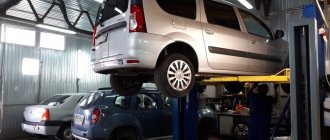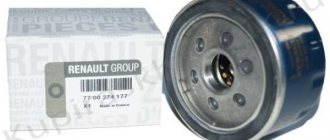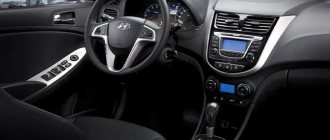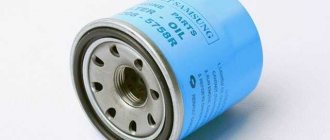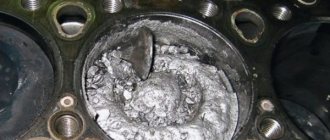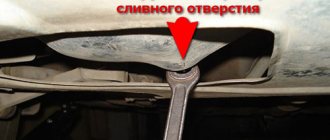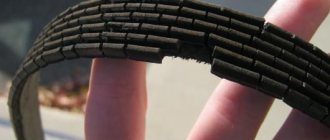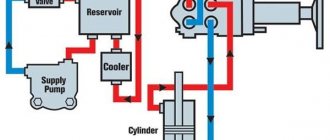Changing the oil of Hyundai Solaris (Accent 4th generation, 2013) is included in the list of routine vehicle maintenance procedures. Changing the oil and oil filter yourself is very simple. This instruction with photo will show how to change the oil in the 1.6 Gamma GDI Hyundai Solaris/Accent engine.
To change the engine oil you will need : a ratchet with a 17mm socket, an oil filter puller (possibly), a jack with stops or a car ramp, a rag, a funnel, an empty container for used oil, a new drain bolt gasket, a new oil filter and a 4mm canister of fresh oil liters
2272-4-7-a-06
Apply engine oil to the filter O-ring.
We wrap the oil filter by hand until the sealing ring touches the oil filter bracket. Then turn the filter another 3/4 turn to seal the connection. Pour 3.3 liters of oil into the engine through the oil filler neck. Screw the oil filler cap clockwise. We start the engine for 1–2 minutes. We make sure that the indicator of insufficient (emergency) oil pressure in the engine in the instrument cluster has gone out and there are no oil leaks from under the plug and filter. If necessary, tighten the drain plug and filter. We stop the engine, after a few minutes (so that the oil has time to drain into the oil pan), check the oil level and bring it to normal.
[We save up to 5,000 rubles on Hyundai Solaris maintenance] [Hyundai Solaris maintenance for 15 thousand kilometers] [Hyundai Solaris maintenance for 45 thousand kilometers] [Hyundai Solaris maintenance for 60 thousand kilometers] [Do it yourself Maintenance - general recommendations] [Safety rules for carrying out vehicle maintenance yourself] [ Tools required for maintenance of Hyundai Solaris]
Changing the engine oil and oil filter Hyundai Solaris
Step-by-step instruction
To carry out an oil change yourself, you need to follow the following instructions:
- First you need to open the hood of the car and remove the cap from the oil reservoir;
- Next, the used lubricant is drained. To do this, place a reservoir with a funnel under the drain plug, remove the lid and wait for the final drainage of the liquid. To speed up the process, warm up the engine before replacing;
- The plug is closed, the engine protection is put back;
- The filter is being replaced. In some cases it will be necessary to use a special puller. Before installing a new one, it is necessary to fill it with fresh oil in a small amount;
- Oil is poured into the reservoir. It is necessary to ensure that the liquid does not exceed the maximum mark in the tank.
How to distinguish a fake from an original filter on a Hyundai Solaris
You can purchase consumables, including MF, in various places, namely:
- at the car market;
- in a specialized store;
- in online catalogues;
- through intermediaries.
Given the breadth of choice, for an inexperienced owner the risk of purchasing non-original products increases due to insufficient knowledge of unmasking factors.
When selecting consumables, be sure to check the availability of:
- and integrity of branded cardboard packaging;
- holographic protection from the front of the package;
- factory stamp with batch number, date of manufacture, country of origin;
- rubber seal on the inner diameter of the MF.
When purchasing, check for a quality certificate or other documentary materials indicating the origin of the product. If in doubt, refuse.
Good non-original filters: articles, price
Specifications (size):
- outer diameter: 81.5 mm;
- screw thread: M20x1.5;
- internal diameter: 56.6 mm.
| vendor code | Price in rubles | ||
| H13W01 | PH6811 | W 811/80 | From 430 – 470 |
| C-1016 | TF 24 | LC-331 | From 430 – 470 |
| PF4076 | CMZ11431 | LS489A | From 430 – 470 |
| W811/80 | COF100119S | ADS72101 | From 430 – 470 |
| HU 7001 x | OF 1101 | 451103316 | From 430 – 470 |
| 1ECO076 | H13W01 | OP617 | From 430 – 470 |
| 10498 | E825H D265 | N1310510 | From 430 – 470 |
| C-1016 | PH6811 | DO 324 | From 430 – 470 |
| CMZ11431 | EOF251 | PF4076 | From 430 – 470 |
| OX 351D | ADS72101 | LS489A | From 430 – 470 |
| 10-04-498 | OX 351D | 0 451 103 316 | From 430 – 470 |
| *prices are as of July 2022 |
Checking the oil level
If the oil level in a new car does not require regular checking, then over time this procedure will need to be carried out more often. There are cases when the engine begins to require adding fluid of 0.5 liters or more after a mileage of only 20,000 kilometers. If such a fact occurs and the car is under warranty, you must contact official dealers to find out the reason.
The oil level is checked in the traditional way - using an oil dipstick with the engine turned off after 20-30 minutes after stopping it. When removing the measuring element, do not try to turn it upside down. Take the measurement with the probe in a vertical position.
How to choose oil viscosity
The choice of oil viscosity depends on the conditions in which the machine will be operated and its technical condition. The condition of the engine plays the most important role. It is necessary to take into account malfunctions in engine operation - loss of oil pressure, etc. If the engine is in order, you can use oil in Solaris of any viscosity, depending on the climatic conditions.
Recommended oil SAE 5w - 30 for Hyundai cars
For all-season use, with the condition of energy saving, maintaining low and high temperature conditions, oil with a viscosity level of SAE 5w - 30 will be suitable for Hyundai Solaris. This is the optimal viscosity, designed for the Japanese and American auto industry, regardless of how long ago they were produced and the general condition of the engine . Solaris oil with a viscosity level of 10w - 30 can be an inexpensive replacement. For European cars, it is perfect as a universal oil with a viscosity level of SAE 5W - 40 or 10W - 40.
In case of engine malfunctions, it is better not to look at low-viscosity and energy-saving oils. Reduced low-temperature or increased high-temperature viscosity can have a negative impact on an already worn-out engine, since when there are disturbances in the engine’s operating mode, the protective film of oil that appears thins and loses strength, which does not allow adequate protection of parts from wear and damage.
You should know that low-viscosity oil for Hyundai Solaris has a high level of evaporation, which increases consumption. In these situations, it is preferable to choose from oils that have a higher viscosity in operating mode. The following types of oils are suitable: viscosity 5W – 50, 10W – 50, 10W – 60, 15W – 50, 20W – 50.
In modern cars, in order to reduce fuel consumption, it is recommended to fill in engine oil for Hyundai Solaris with low viscosity, but for this, the engine design must be made to use low-viscosity oils. It is important to know that it is not advisable to use this type of oil in cars of older years of manufacture, since failures in the standard performance of the engine and the possibility of early wear of parts are possible. This can be attributed to oil, which has the classifications ACEA A1/B1, A5/B5, ACEA C1, C2; VW 503.00/506.00/506.01; Ford 913 A/B or HTHS marking.
Coolant for Hyundai Solaris
The manufacturer recommends using long-life antifreeze G-11 (green). For temperate climates, the concentration should be calculated at -30°C, and for cold climates -40°. Service life 120,000 km or 2-3 years of operation. It must be borne in mind that G-11 cannot be mixed with G-12 in the Hyundai Solaris cooling system.
In cars with 1.4 engines, the volume of the cooling system is 5.3 liters. With a 1.6 engine, the system volume is 6 liters.
Where is the oil filter located?
Viewable from above, but access from here is difficult
Bottom view, if there is no metal protection for the engine
Access to the oil filter is only from below
Replacement frequency, what oil to fill
According to the manufacturer's regulations, engine oil service changes are carried out after 15,000 kilometers or at intervals of 1 year. But many motorists consider this interval to be very high, recommending that it be halved.
According to the recommendation of the automobile concern, the original Hyundai Premium LF 5W-20 synthetic oil should be used to fill the lubrication system. The use of semi-synthetic Hyundai Super Extra 5W-30 is allowed.
From the factory, Hyundai Solaris models are filled with the synthetic compound Shell Helix Ultra 5W-20. But on the Internet you can often find reviews from people that they have filled in oil with other viscosity parameters, for example 5W40. Most likely this is due to the operation of the car in different climatic zones, as well as at different dealers.
If you try to figure out which analogue oil to pour into these engines, you may encounter confusion in official documents. In the service instructions, the manufacturer recommends that when choosing, rely on API data: SM; ILSAC: GF-4.
Although dealers at their repair stations for some reason recommend choosing a lubricant based on API tolerances: SL; ACEA: A3. Although ACEA approval: A3 is not very suitable for Gamma motors, as it will be too viscous. According to the recommendations of motorists, ACEA: A5 would be more suitable.
Everyone has their own preferences regarding the brands of oil manufacturers. Some use Korean ones, others look for cheaper ones and use Lukoil. But most trust global brands such as Elf, Shell or Liqui Molly.
To summarize the above, engine oil should be selected that meets API tolerances: SM; ILSAC: GF-4. If it is impossible to buy a lubricant with these tolerances, you can opt for ACEA: A5.
How much oil is in the engine lubrication system, volume table
| Model | Engine capacity | Motor marking | How many liters of oil are in the system | Original oil / factory filled |
| Hyundai Solaris | gasoline 1.6 | G4FC | 3.3 | Shell Helix Ultra 5W-20 / Hyundai Premium LF 5W-20 / Hyundai Super Extra 5W-30 |
| gasoline 1.4 | G4FA | 3.3 | ||
| G4LC | 3.5 |
Choosing an oil base
Choosing engine oil for Hyundai Solaris
More often, the question of selecting oil for Hyundai Solaris most likely relates to problematic engines. Mineral, semi-synthetic and synthetic oils can contain the same properties for operation, can be endowed with the same classifications and specifications and have differences only in thickness and differences in bases. Oils of different thicknesses, with the same operating properties, can in certain situations temporarily solve specific problems of a worn-out engine.
For example, a mineral oil SAE 15W - 40 will have a slightly higher kinematic viscosity at 100 degrees when compared with most synthetic oils with a viscosity of 5W - 40. This way, in a maintained engine at operating temperature, you can create a thicker and stronger oil film, thus providing protection against further wear and stabilization of system components. The level of oil waste is reduced and an engine using mineral oil, when compared with semi-synthetics and synthetics, creates the appearance of normal operation.
Consequences of untimely replacement
If you don't change the oil on time, the saddest consequence will be failure of the car's engine. The car owner will have to do major repairs, which is quite expensive. The internal elements of the engine will begin to wear out faster due to oil starvation, and the pressure in the lubrication system will drop.
As a result, the power of the power unit will begin to decrease, dips will appear when you press the gas pedal, the engine will “triple”, and the hydraulic compensators will begin to knock. There will be difficulties starting the engine in cold weather; its wear and tear when operating in cold conditions will increase several times.
Choosing oil depending on the season
When changing oil on a Hyundai Solaris in the warm season, a mineral oil with a viscosity of 15W - 40 or 20W - 50 (if the manufacturer allows their use) may be suitable for worn engines. Also in winter and in the off-season you should choose synthetic and semi-synthetic oil with a high viscosity level. It can be 5W - 50, 10W - 50, or 10W - 60.
When oils with high viscosity are used, it is worth replacing more often, almost 2 times. This is because the oil oxidizes more quickly on a worn engine and contains more viscosity additives.
Under the influence of high operating temperatures, the additives change their properties and structure and, as a result, the viscosity decreases, and the particles formed during destruction additionally form carbon deposits and deposits. The frequency of oil changes should also be reduced if there is a change from one type of base to another.
